Worlds Within Worlds: The First Heroic Fantasy (Part II)
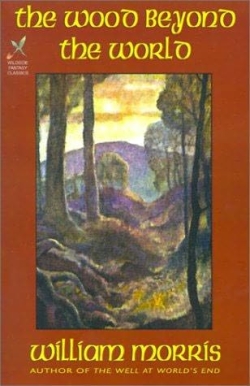 This is the second post in a series trying to answer what looks like a simple question: who wrote the first fantasy set entirely in another world? As I found in my first post, to answer that question you first have to decide how to define a fantasy otherworld. I came up with a list of four characteristics: whether the world has a distinct logic to it, such as the use of magic; whether the people in the world are meant to be perceived as residents of this world; whether the world has its own history; and whether it has its own geography. It seems to me most otherworlds have all four characteristics, with a few interesting cases getting by with three. Any less than three, and you don’t have an otherworld.
This is the second post in a series trying to answer what looks like a simple question: who wrote the first fantasy set entirely in another world? As I found in my first post, to answer that question you first have to decide how to define a fantasy otherworld. I came up with a list of four characteristics: whether the world has a distinct logic to it, such as the use of magic; whether the people in the world are meant to be perceived as residents of this world; whether the world has its own history; and whether it has its own geography. It seems to me most otherworlds have all four characteristics, with a few interesting cases getting by with three. Any less than three, and you don’t have an otherworld.
Now, traditionally, William Morris has been considered to be the first writer to have set a story entirely in a fantastic otherworld; that is, to write a story in which the real world as we know it never appeared. His was the name suggested by Lin Carter and L. Sprague de Camp, it was accepted by John Clute and John Grant in their 1997 Encyclopedia of Fantasy, and it’s found a place in the repository of all human knowledge, Wikipedia. I, however, am disagreeing; I’ve found an a writer from a few decades before Morris who wrote something that seems to me to be an otherworld fantasy.
Before naming that writer, though, I’d like to tackle a related question. And that is: why did it take so long for somebody to come up with the idea?
Consider: Morris’ The Wood Beyond the World was published in 1894. Even if the first otherworld fantasy was in fact a few decades earlier, then people were still telling tales for thousands of years before coming up with the idea of an independent world (it would be interesting to see when the term ‘world’ began being used in criticism, as in ‘the world of Dickens’ or ‘Shakespeare’s green world’). Why the long delay?
It’s not because people were less imaginative. Rather, it seems to me, looking at older stories containing fantastic material — stories close to being high fantasy — that certain structural devices keep recurring, which in retrospect prevented the need for the development of the idea of an otherworld independent of the ‘real world’. These devices were ways for a story to contain strong fantasy elements while also situating them in this world. You can find stories from before 1800 in which a setting seems to fit three or even four of the characteristics I listed in my first post; but, rather than be established as its own world, the setting is, one way or another, given a relation to conventional reality.
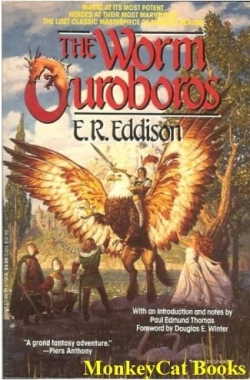 Essentially, these techniques all link otherworlds to this world; they’re a variety of frames, if you like, which rein in fantasy. You could probably say that Tolkien, Robert E. Howard, Clark Ashton Smith, and other early fantasy writers who tied their fictional worlds to the real world were perhaps inheritors of that earlier way of thinking about fantasy. Consider E.R. Eddison, who began The Worm Ouroboros with a character from this world, brought him in an out-of-body reverie to a fantasy Mercury, and then never mentioned him again; presumably that structural choice was an attempt to give the book a real-world frame.
Essentially, these techniques all link otherworlds to this world; they’re a variety of frames, if you like, which rein in fantasy. You could probably say that Tolkien, Robert E. Howard, Clark Ashton Smith, and other early fantasy writers who tied their fictional worlds to the real world were perhaps inheritors of that earlier way of thinking about fantasy. Consider E.R. Eddison, who began The Worm Ouroboros with a character from this world, brought him in an out-of-body reverie to a fantasy Mercury, and then never mentioned him again; presumably that structural choice was an attempt to give the book a real-world frame.
It may be more accurate, though, to turn my phrasing around. Rather than talking about frames or links to this world, we could say that there are a number of techniques by which fantasists displaced their fantasy, putting it beyond the bounds of the world of everyday life. The idea of the otherworld, then, is just one of the most recent displacement strategies to be developed. You could even say it’s the most sophisticated, because it most thoroughly embraces the idea of fiction as fiction, of a story as a self-contained creation that does not need to be justified by a precise placement in relation to the real world.
All of which, to me, only makes the original question more significant: who was the first person to throw off that need to link fantasy to reality?
I’ll get to my nomination in a little while. But before I do, I’d like to take a closer look at those framing techniques, or displacement techniques, and consider the way past fantasy worlds have been linked to this world. Basically, I’d like to consider why the otherworld approach to setting never came up before a certain point in time. Then, in my next post, I’ll give some examples of close or borderline cases, stories that came close to being an otherworld fantasy, or indeed might be otherworld fantasy if you look at them in a certain way. Finally, I’ll explain my choice for the first otherworld fantasy writer, and what I think that means for the way we think about the history of fantasy.
Note that, obviously, my discussion of literary history is limited by my knowledge and reading. I think I’ve a reasonably good grasp of the history of English and North American literature, a lesser knowledge of Western European literature in general, and a corresponding decline in knowledge of literatures beyond those. So, inevitably, there are gaps; even the literatures I know well I can’t know exhaustively. I encourage anybody who knows more than I do to take issue with anything I get wrong, and especially to suggest anything that I’ve overlooked.
Now, let me at this point suggest some definitions that may be useful in the course of this discussion. Terms like ‘otherworld’, ‘fantasy’, and especially ‘high fantasy’ can mean different things to different people, so it may be better to nail down their meaning right now.
For the purposes of these posts, I will mean fantasy to refer to any story with elements of magic or the supernatural. I will mean high fantasy to refer to fantasy stories in which the fantasy element or elements so dominates the setting, or is so extensive, that the setting (or some part of it) appears or begins to appear to be another world. I will mean otherworld fantasy to refer to a fantasy set entirely on a world that is not this one, and which has no link whatsoever to conventional reality. So, otherworld fantasy is effectively a subset of high fantasy, which is a subset of fantasy.
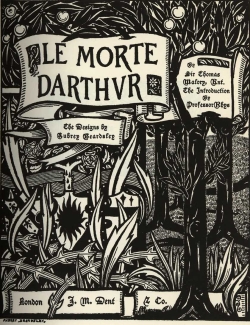 But looking at those definitions, I think I should make a distinction. It feels intuitively wrong to me to call, say, The Pilgrim’s Progress or Le Morte d’Arthur high fantasy. But why? What makes them distinct from The Lord of the Rings, in terms of how they present their fantasy, and how they relate their fantasy to the real world?
But looking at those definitions, I think I should make a distinction. It feels intuitively wrong to me to call, say, The Pilgrim’s Progress or Le Morte d’Arthur high fantasy. But why? What makes them distinct from The Lord of the Rings, in terms of how they present their fantasy, and how they relate their fantasy to the real world?
Well, whether you accept Morris as the first otherworld fantasy writer or not, The Lord of the Rings was written after otherworld fantasies were invented. Which is to say that Tolkien made a choice to connect his world to the real world in a way that the earlier writers didn’t. Given that, let’s say that high fantasy will be used for fantasies of that type written after the invention of otherworld fantasy, and traditional fantasy will be used for works written beforehand.
So, all that said, how has the fantastic traditionally been tied to the realistic? Another way to put it: how has the fantastic been isolated from the real and the known? How has it been displaced into its own realm?
Let me ask firstly, what happens if there is no displacement? What happens if the real world is depicted as an otherworld, a place not just where fantastic events can happen, but where the world is shaped by the fantasy? What if this is intended not just as matter for a story, but as something every bit as plausible as what we now think of as realist fiction?
This seems like a paradox, but in fact what I am talking about is myth. Myths, of course, describe events or stories beyond common experience. But, and this is my point, they also are meant to illuminate the real world.
A myth describing the way the world was brought into being necessarily includes the world. A myth that describes how the seasons were created is a myth that explains how the things we know, the reality we know, took the shape that it does. The progression of myth, then, is in a sense from the fantastic to the realistic. And myths always include this world, explaining it, giving meaning to it, presenting a history for it, but effectively with the aim of buttressing the real.
At the same time, myth argues that the world, understood in a certain way, is in itself fantastic. A storyteller could therefore include fantastic material within a retelling of a myth. But the mythic structure meant that the fantasy was always linked to something real, something known.
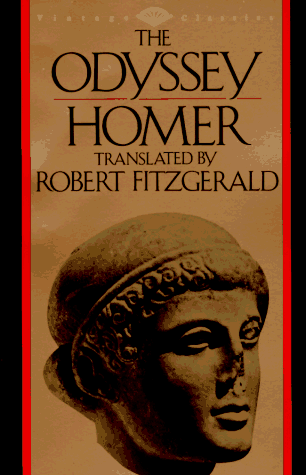 Consider The Epic of Gilgamesh and The Odyssey, both of which involve journeys around far parts of the world, and then journeys back to the real world. They have their own logic, in the sense that (I think) even in the context of the societies that birthed them, they told of wondrous and impossible things; they describe fictional geographies, extending beyond what was known of the world; and they have their own histories to go with that geography — Gilgamesh meets the survivor of a flood at the dawn of time, Odysseus is haunted by the Trojan War that ended before his epic began. But, in the end, their stories are as much about what happens when they return home as they are about what they find beyond the fields we know.
Consider The Epic of Gilgamesh and The Odyssey, both of which involve journeys around far parts of the world, and then journeys back to the real world. They have their own logic, in the sense that (I think) even in the context of the societies that birthed them, they told of wondrous and impossible things; they describe fictional geographies, extending beyond what was known of the world; and they have their own histories to go with that geography — Gilgamesh meets the survivor of a flood at the dawn of time, Odysseus is haunted by the Trojan War that ended before his epic began. But, in the end, their stories are as much about what happens when they return home as they are about what they find beyond the fields we know.
You could argue that some myths seem more self-contained. The story of the battle between Marduk and Tiamat seems fairly removed from the real world — but the conclusion of the story, when Marduk makes the universe out of Tiamat’s corpse, establishes that the real world is in fact what they’re fighting over. It seems to me that, one way or another, the world of human experience always either enters into, or is subsumed by, the fantasy in a myth. In both cases, the fantasy is tied to reality.
Also worth talking about here are works that aren’t traditional myths, but which were meant to serve a mythic function. The Divine Comedy, for example, or Paradise Lost. Or consider William Blake’s epics about fantastic Gods; again, he’s trying to explain this world, and how it was created, and how it fits into his concept of the universe. His writing (I feel) grew more fantastic as he grew older, to the point where he was essentially creating worlds for his characters to adventure in — but while creating all sorts of fantastic geographies, he also anchored his stories to the geography of this world, both literally and symbolically.
To say these things is not to demean myth (or any of the specific works I’ve mentioned), nor is to diminish the real wonder that myths possess. It’s just to say that myths can’t be a full otherworld fantasy because they don’t imagine a new world; they explain this one. The structure of myth acts to contain fantasy. As I said up above, it’s a displacement strategy without any actual displacement.
So that’s the first technique to tie a fantasy otherworld to reality. What others are there?
Well, the most immediately obvious sort of displacement strategy is a literal displacement: situate the fantastic world in a part of the real world that nobody knows anything about. In other words, displace the fantasy world geographically. This was most useful, of course, when there were parts of the world that nobody knew anything about — or when education was so rare most people had only the haziest of ideas about what other places were like, and whether you could ride from Brittany into England (you couldn’t, but that didn’t stop Wolfram von Eschenbach from saying you could in his thirteenth-century poem Parzival), or whether Bohemia had a seacoast (it doesn’t, but try telling that to William Shakespeare).
Often, fantastic otherworlds are displaced into areas of remarkable isolation. Islands are a perennial favourite. But underground realms have been fairly popular as well.
I suspect the last real use of this strategy was in planetary romance stories — things like Burroughs’ Martian adventures. The fantastic otherworld here takes on the shading of a science-fictional otherworld. C.S. Lewis’ Space Trilogy, or E.R. Eddison’s Mercury, return to fantastic treatments of the same idea just as their settings (with the passing of time) have become more implausible than Burroughs’.
If displacing a fantasy world geographically is one traditional displacement strategy, then so is displacing it historically. Specifically, traditional fantasy seems often to be placed in a setting, an era, already famous for magic and legends — in the reign of King Arthur, for example, or Charlemagne, or Haroun al-Raschid.
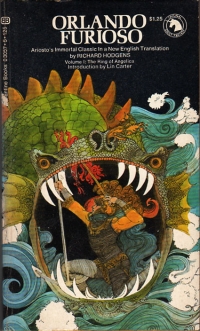 The wildest of these fantasies, it seems to me, were written by people not native to the legendary tradition in question. That is, French and German writers produced many of the strangest Arthurian stories (and invented the Holy Grail), while Italian writers created wild fantasies about adventures that befell Charlemagne’s knights, sending them on trips to the moon, or into combat with giants and wizards.
The wildest of these fantasies, it seems to me, were written by people not native to the legendary tradition in question. That is, French and German writers produced many of the strangest Arthurian stories (and invented the Holy Grail), while Italian writers created wild fantasies about adventures that befell Charlemagne’s knights, sending them on trips to the moon, or into combat with giants and wizards.
These writers weren’t interested in history; they were writing fantasy, and using figures around whom tales were already being told as characters in the stories they wanted to tell. So I wonder whether, in fact, being from a different culture or country gave them a greater freedom to play with their fantasy; they weren’t, after all, messing about with their own past.
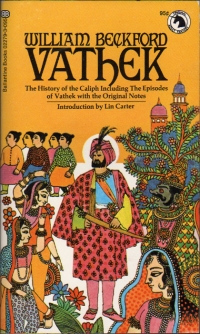 Arabian Nights pastiches are a good example. Relatively few English writers have written stories based on the Arabian Nights, and one of those, William Beckford, originally wrote his tale, a 1782 novel called Vathek, in French. But a startling number of French fantastists wrote Arabian stories, particularly around the 18th century. One wonders if, for those writers, the faraway land of Arabia in fact signified what an otherworld does for us.
Arabian Nights pastiches are a good example. Relatively few English writers have written stories based on the Arabian Nights, and one of those, William Beckford, originally wrote his tale, a 1782 novel called Vathek, in French. But a startling number of French fantastists wrote Arabian stories, particularly around the 18th century. One wonders if, for those writers, the faraway land of Arabia in fact signified what an otherworld does for us.
So much for time and space. Are there other possible displacement strategies? Sure. Perhaps the simplest of all ways to link a fantasy world to this world is to say that it’s a dream. In a dream, after all, anything can happen, however fantastic. It is perhaps not surprising, though, that most traditional fantasties that use the dream framing technique don’t actually feel like dreams — they don’t have the surreal, chaotic sense of a dream, and instead unfold with some kind of actual narrative structure.
On the other hand, the dream frame was a particular favourite, it seems, of allegorists — writers who wanted to make a point about this world by following a character through a symbolic tale that acted, for all intents and purposes, like a giant editorial cartoon. Everything in the allegory, everything in the setting, every character, is meant to represent a specific thing or idea. So the upshot of this was often a kind of surrealism in which a given story element might stand for something completely different; and at least in that duality, that telescoping of two unrelated things into one, it might be said to mimic a dream.
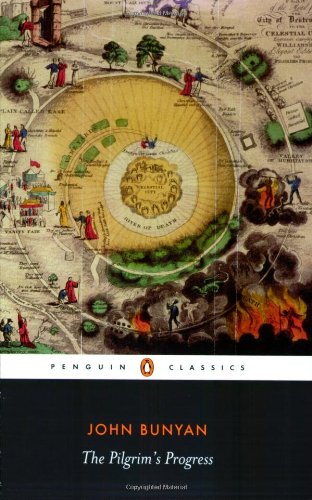 The best allegories, though, maintained an inherent logic while still functioning as a story. One of the great examples in English is The Pilgrim’s Progress, which is symbolically about the soul overcoming temptation to make its way to heaven. So the book follows its main character, Christian, as he tries to make his way to the Celestial City atop Mount Zion, struggling through places like the Slough of Despond and Vanity Fair, and fighting against monsters like the Giant Despair. It is, in form, an adventure story in a fantastic world — but it’s also explicitly stated to be a dream.
The best allegories, though, maintained an inherent logic while still functioning as a story. One of the great examples in English is The Pilgrim’s Progress, which is symbolically about the soul overcoming temptation to make its way to heaven. So the book follows its main character, Christian, as he tries to make his way to the Celestial City atop Mount Zion, struggling through places like the Slough of Despond and Vanity Fair, and fighting against monsters like the Giant Despair. It is, in form, an adventure story in a fantastic world — but it’s also explicitly stated to be a dream.
A lot of the great allegories, though not all, are dreams; consider Piers Plowman, or the Roman de la Rose. The Roman de la Rose is worth looking at here, or at least its opening. I have a translation into modern English which begins: “Many a man holds dreams to be but lies, / All fabulous; but there have been some dreams / No whit deceptive, as was later found … I have full confidence / That visions are significant to man / Of good and evil. Many dream at night / Obscure forecasts of imminent events.” This is a useful reminder that dreams once held a significance that they mostly don’t today. Like Arabia was to 18th century French writers, dreams were another world, or a place where another world could be imagined.
Are there any more such venues for imagining a world? Are there any other frames, or displacement strategies? Yes, certainly. You could tell a story as a story within a story: as something one character tells another. That lets you tell the tale while displacing the fantasy world into — well, into the sphere of pure fiction.
This sounds at first like a very modern structural technique, but many of the great medieval story collections, like The Canterbury Tales or The Decameron, had a frame narrative that established that all the stories in the work were being told by one person to another, or indeed by various people to each other.
Consider also the “club story”. In its classic formulation, one character in an English gentleman’s club (or similar environment) tells a story that allegedly happened to him, or that he witnessed, to the other club members. It is thus potentially a way to present a fantasy while still dismissing it as just something somebody said. You can find several notable early fantasists using this structure, among them Lord Dunsany (who may have invented the form).
Under whatever approach, this kind of displacement strategy may be the most effective, or most complete, way to dislocate a fantasy story of any kind. It displaces the fantasy into a story. It empahsises the fantasy’s status as fiction, as something somebody says to somebody else. It pushes the fantasy one level further away from the real.
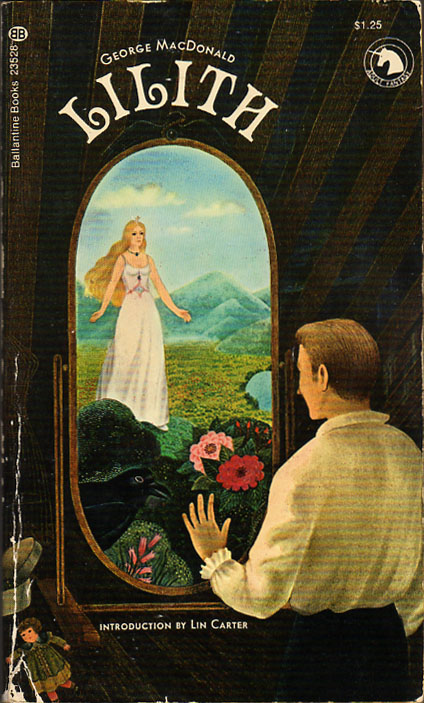 On the flip side, it seems to be around the 19th century that stories began to be written in which the idea of a fantastic otherworld becomes literalised. That is, in some stories from about this time, you can see another world — a physical and usually enchanted place not connected to the real world by conventional geography — and typically follow a character from this world as they enter into it; Alice falling into Wonderland. George MacDonald’s 1895 novel Lilith, in which the main character crosses over into another world by stepping through a mirror, is another example.
On the flip side, it seems to be around the 19th century that stories began to be written in which the idea of a fantastic otherworld becomes literalised. That is, in some stories from about this time, you can see another world — a physical and usually enchanted place not connected to the real world by conventional geography — and typically follow a character from this world as they enter into it; Alice falling into Wonderland. George MacDonald’s 1895 novel Lilith, in which the main character crosses over into another world by stepping through a mirror, is another example.
The three foregoing techniques can be brought together in interesting ways. A writer can play about with reality, and shift perspectives intriguingly, by balancing dream, story, and otherworld.
Consider E.T.A. Hoffmann’s intricate fairy tale, Nutcracker and the King of Mice. To oversimplify: a little girl sees some strange events, and faints; she wakes up to find it was all a dream. Then her Godfather tells her a story, which ends up connecting with the things she saw, and which then leads into her becoming involved in more fantastic events — at the end of which she falls asleep, and wakes up to again have her parents tell her everything was a dream. Except that she has proof of the fantastic events, and in the end her Godpapa’s nephew, who she met in the ‘dream’, comes to her in real life; she marries him, and the story ends by telling us that “Marie is to this day the queen of a realm where all kinds of sparkling Christmas Woods, and transparent marzipan castles—in short, the most wonderful and beautiful things of every kind—are to be seen—by those who have the eyes to see them.”
What happens here is that by hinting that the fantasy is only a dream, and then only a fiction, and then removing those possibilities, Hoffmann seems to insist on the actuality of the fantasy. Paradoxically, the line “by those who have the eyes to see them” then actually tends to undermine the fantasy he’s created, hinting that after all the whole thing’s a matter of perspective.
In general, it would be a mistake to assume that a work must use only one displacement strategy to establish reality’s distance from the fantasy world. Consider the movie version of The Wizard of Oz; in that telling of the story, not only is Dorothy swept away from Kansas by a whirlwind, she also wakes up at the end to find out the whole thing was a dream — just as Alice falls into Wonderland through a deep pit, but also wakes at the end to find she was dreaming.
Or consider the traveller’s tale, which uses the device of displacing fantasy into a far unknown place, and also fictionalises the fantasy by insisting that, after all, what you’re reading is only a story or letter. This isn’t always the case; Lucian’s True History (which dates back to the second century AD) is just a first-person narrative of a man who ends up travelling to some very strange places. But often you find a more detailed frame, as in Thomas More’s Utopia, which consists of the recollections of a sea-captain who visited the fictional land — as those recollections are narrated to the author.
The use of the tale-telling frame can actually serve to make the fantasy more real, by giving it a kind of background — not only a reason for being told, but a claim to authenticity. Consider the letters which circulated in the middle ages claiming to be from a mythic Chirstian King called Prester John, and which claimed all sorts of wonders could be found in John’s nonexistent land. Or look at the “travels” recounted by “Sir John Mandeville, Knight”, actually a collection of fantasies about what existed beyond the bounds of the known medieval world, as recounted by a man who claimed to have seen them all for himself (including Prester John’s kingdom). Although mostly a fiction, the book was taken as largely true for centuries.
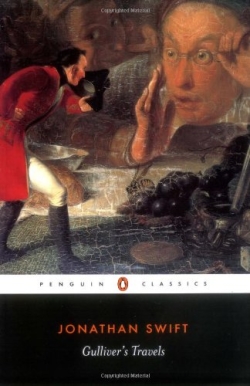 Perhaps the ultimate example of the credibility that a well-written fictional frame can provide a work comes from one response to Gulliver’s Travels. So convincing is the book’s use of the device of the traveller’s tale that, according to Swift, one bishop who read the book said that it “was full of improbable lies, and for his part, he hardly believed a word of it”.
Perhaps the ultimate example of the credibility that a well-written fictional frame can provide a work comes from one response to Gulliver’s Travels. So convincing is the book’s use of the device of the traveller’s tale that, according to Swift, one bishop who read the book said that it “was full of improbable lies, and for his part, he hardly believed a word of it”.
Which does anyway suggest one reason writers were in no hurry to invent fictional otherworlds: they didn’t really need to. For a very long time, this world was large enough.
(And it is perhaps notable that the world ‘multiverse’, in the sense of a complex of co-existing universes, fictional or otherwise, was first used by Michael Moorcock in 1962, following certain then-new theories in physics. I think the broad acceptance of otherworld fantasies has largely come about since that point. If the notion of a multiverse has become increasingly mainstream, then that suggests that notwithstanding a few early outliers, we may actually be looking here at the most recent iteration of the geographical displacement strategy: moving fantasy into another dimension.)
Still, it’s interesting to me that there seems also to be a need for so many different kinds of displacements, and a need as well to combine them in increasingly complex ways. If the otherworld fantasy is the ultimate displacement strategy, a movement of fantasy into its own world, its own reality, what does that mean about those kinds of stories? What, ultimately, is the importance of the otherworld fantasy?
It seems to me that if the otherworld is, as I say, displacement taken to the extreme, one could also say it is a displacement of fantasy to somewhere near where it started out: as myth. The otherworld fantasy is effectively a cosmological event, the building of a new world, a new universe, with its own myths and its own reasons for being.
What I want to suggest, then, is that the otherworld fantasy is in a way the ultimate expression of a certain kind of structure. This is not to suggest that Tolkien, or Howard, or Lewis Carroll, or John Bunyan or Jonathan Swift or anyone else who used one or more of the strategies listed above, were using an inferior or defective structure for their particular work. I mean only that the otherworld seems to me to be the uttermost development possible of the desire to create a place for fantasy.
More, it seems to me that the otherworld, as an independent fictional creation, sealed hermetically away from the conventional world, suggests the potential in fiction to entirely re-imagine the world. One reason why writers created the displacement strategies, I think, was precisely to lead bishops into seriously contemplating the existence of Lilliput and Brobdingnag; to lead readers to accept fiction as possible reality. To ease the willing suspension of disbelief. I think the otherworld is a dramatic statement insisting on that disbelief: this is not the world you know; there are others, and here is one of them.
Sir Philip Sidney once wrote that “a poet can scarcely be a liar … he nothing affirms, and therefore never lieth.” He meant that a poet, an imaginative writer, does not present a story as fact. The writer presents the story as a story; a kind of hypothesis. You can take it for true, or hardly believe a word of it. Or accept the story as what it is, a story, just that.
I think that an otherworld fantasy is the ultimate expression of that “nothing affirms”. Here is a story, the fantasist says, and it is a fiction, and its world is a fiction; as are all worlds in all fictions. It is a hypothesis; it is a dream; it is a myth. It has its own integrity. It has its own reality. And that reality is not such as should be confused with the reality we see around us.
And, implicitly, that self-sufficient reality in a fiction can challenge us: how much of what we think we know about the world around us is real? How much of what we think is real is only a fiction we have constructed for ourselves, and how much do we each live in our own worlds?
So much, then, for why I think otherworld fantasies are important. It returns us to the question: who created the first one?
More thinking about that question here, and my final answer is here.
Matthew David Surridge is the author of “The Word of Azrael,” from Black Gate 14. His blog is Hochelaga Depicta.
[…] of another world than our own, a coherent history, and a coherent fictional geography. In the second post, I considered ways in which older fantasies were linked to reality — by being set in the past, or […]
[…] on that here, a bit more here, and I name the book I think is the first otherworld fantasy here. Matthew David […]
[…] I first started to get a hint of what I was looking for when I was putting together the series of posts about Sara Coleridge, the first writer of heroic fantasy. In those posts, I tried to describe the […]